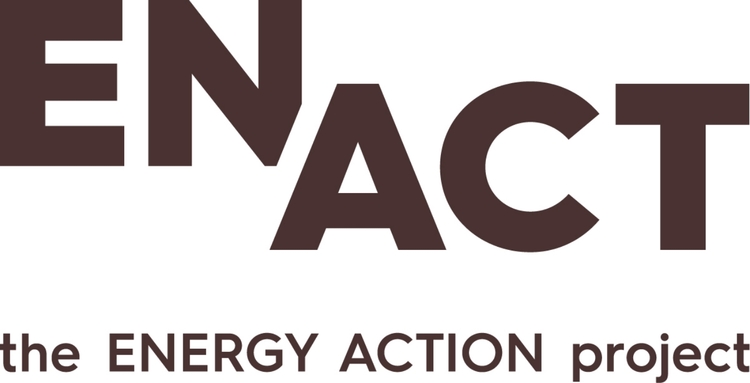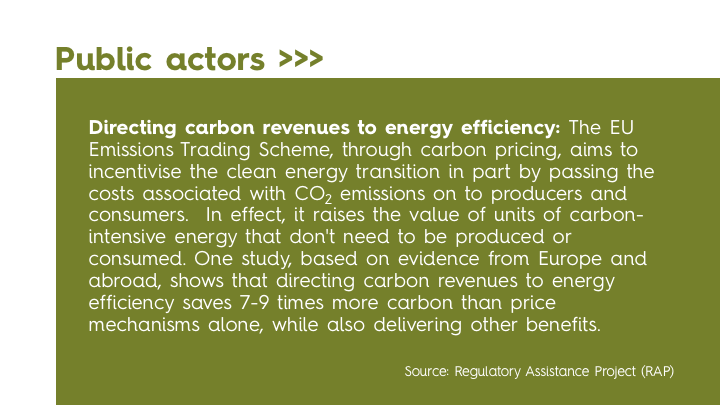Financing deep energy renovation: policy action, public-private partnerships and financial tools
Within the EU context and existing 2030 energy savings targets, Renovate Europe notes an annual investment gap of €130-200 bn. Some 80% of the investment is needed on the demand side, of which 71% must be directed to the residential sector, which is noted as being particularly challenging because the need for both action and financing is extremely granular.
Over the longer term – i.e. to 2050 – boosting the energy renovation rate to 3% annually would achieve the ambitious goal of reducing energy demand in buildings by 80% while drastically cutting carbon dioxide (CO2) emissions. In turn, this would cut total EU energy demand by 30%, reduce energy bills for all consumers, enhance productivity and increase property value and rentals. Such benefits could boost GDP by 0.7% annually; in 2020 alone, that would equal €39 bn in additional public finances.
Energy renovations could lead to a 0.7% boost in annual GDP. Photo: ljubaphoto
Renovate Europe calls upon EU institutions to ensure that the European Green Deal creates the ecosystem for deep energy renovation, including establishing stability that will eliminate the current ‘stop-go’ dynamic that erodes investor confidence. This includes making energy efficiency a top priority and planning beyond short-term measures.
While this briefing focuses on the need for strong policy, the potential of public-private partnerships, and the particular challenges of financing renovation in the residential sector, a complementary briefing examines ways to leverage funds through the Just Transition Mechanism and carbon revenues.
Powerful examples of policy action and public-private partnerships
When access to base financing and overarching targets that set the stage for implementing new policies and regulation are in place, national and local governments are empowered to engage with a wide range of entities to carry forward renovation strategies.
Two approaches have emerged as effective ways to leverage investment, realise returns (for investors and energy consumers) and build up a skilled workforce. Public-private partnerships (PPPs) typically see a government agency linking with one or more private companies – and perhaps with civil society organisations or other stakeholders – to share the cost of initiatives while also passing on the operational work of project to the entity best suited to carry it out.
Energy service companies (ESCOs) are a type of commercial entity that fits well into the concept of PPPs and, indeed, into the framework of programmes such as the Just Transition Mechanism. Typically, ESCOs have expertise in energy audits and efficiency measures that can dramatically reduce energy consumption, thereby helping their clients to achieve substantial savings on energy bills. Recognising that many clients lack the capital needed to undertake deep renovations, ESCOs participate in financing, usually by setting up a contract in which they cover the initial costs and the client repays with money saved.
Often, the launch of policy and financing mechanisms sets the stage for the PPPs and ESCOs, as described in examples below.
Making 1 m buildings clean and efficient • New York City, Law 97
In May 2019, as part of its Climate Mobilization Act, New York City implemented Law 97,[1] thereby laying the foundation for deep energy renovation of buildings greater than 2 325 m2 (25 000 sq. ft.) – i.e. ~50 000 buildings accounting for almost 60% of floor space in the city.[2] As of 2024, such buildings will be assigned an annual emissions cap, calculated to reflect their primary energy use and square footage.
The law is the outcome of an ‘evolutionary’ approach that first informed building owners with data about actual energy use and information about opportunities for saving through initiatives such as the Greener Greater Buildings Plan. With Law 97, the city now requires that building owners take action, in line with the reality that each building’s cap will decrease over time.
The city’s overall greenhouse gas reduction goals are also progressive, aiming for reductions of 40% by 2030 and 80% by 2050 to reach an average of no more than 1.4 kg of CO2e per square foot per year.
Getting utilities on board for energy efficiency • California Public Utilities Commission
Recognising the need for innovation – and the struggles innovators face – the California Public Utilities Commission (CPUC) have laid out a policy framework to financially support and carry out technical testing of early-stage energy efficiency solutions.[3] With the aim of transforming the market, the strategy authorises an investment fund of $250 m over five years, creates an advisory board to assess viable projects and progress over time; and determines how best to value innovation within the new market transformation framework. Key to the initiative is the establishment of an independent statewide market transformation administrator that will assess all opportunities for new technologies and strategies for homes, buildings and industrial sectors. This programme models an earlier initiative launched by the Northwest Energy Efficiency Alliance.
EU Member States leverage Structural Funds through public-private partnerships
Two EU examples are noteworthy for their use of structural funds, PPPs and ESCOs:
Ljubljana, Slovenia: With its turn to be the European Green Capital on the horizon, the City of Ljubljana needed to take action on upgrading old buildings. To leverage technical expertise and secure financing, the City created a PPP with Petrol, the largest Slovenian energy company, and Resalta, an energy services company (ESCO).
Since 2017, the partners have renovated 48 public buildings, including schools, libraries, cultural institutions, sports centres, etc. Twenty-five of the projects were done to standards qualifying for deep energy renovation while actions possible on some buildings were constrained by their heritage status. Even so, the initiative achieved an average energy reduction of 70% to 85%. Against an initial investment of €14.8 m, the city’s energy bills have been slashed by €1 m annually, suggesting a payback period of 15 years. This innovative approach won the PPP an award from the EU-funded project known as GuarantEE.
Croatia: In 2014, Croatia received €441 m in Structural Funds to pursue large-scale energy efficiency. In this case, working with ESCOs was a key criterion, not only for joint funding but as a mechanism to build up a skilled workforce. In most cases, the government drew on the energy efficiency fund to front 40% of project costs, requiring ESCOs to mobilise the remaining 60%. In turn, ESCOs established contracts with building owners/operators by which they agree to re-pay the ESCO’s share with finances freed up through substantially reduced energy bills. One example is the Karlovac Hospital: the efficiency measures will allow the hospital to repay its share of €7.2 m in 14 years.
By 2016, using about half of the total funding, the programme had already transformed more than 15 600 family homes, 2 300 multi-unit dwellings, 262 public and 80 commercial buildings. In parallel, 3 000 new jobs were created.
Efficiency measures will allow the Karlovac Hospital, Croatia to repay its energy renovations share of €7.2m over 14 years. Photo: Rudan_doo
Mechanisms for financing energy efficiency of private dwellings
Across the EU, 70% of homes are occupied by individual owners; as with commercial buildings, the majority of existing homes will remain occupied in 2050. This sector is particularly challenging because there are so many types of buildings to consider and, for many households, the thought of financing and managing deep renovations is simply overwhelming.
Accounting for 70% of EU buildings, energy renovations for homeowners and commercial building owners may be more challenging. Photo: nobtis
While the UK is no longer part of the EU, a recent statistic is relevant: meeting long-term emissions targets would imply renovating one building per minute for the next 40 years, at a cost of €100 bn for homes alone.[4] Noting that the UK has had better building codes in place for a much longer time than many MS in Central and Eastern European, its figures are likely low by comparison.
An overarching challenge for homes is that renovations are a discretionary investment decision: building owners need to be persuaded not only of the merits of the energy investment, but to finance it and bear whatever personal disruption it entails.[5] One study found that 58% of owners worried about repaying renovation loans while 53% were deterred by lack of government support for costly works.[6]
Privately owned rental dwellings raise other challenges, particularly that of ‘split incentives’ in that the owner bears the cost of renovation while the tenant receives the benefit of lower energy bills and greater comfort. In fact, 60% of tenants report being worried that landlords who carry out renovations would seek higher rents.
Without going into great detail, it is valuable to highlight practices that have proven effective to stimulate energy efficiency renovations and who should take the lead in rolling them out, namely public actors, utilities and financial institutions.
While all of the above options have proven effective, various experts argue that prompting the scale up of home renovations requires policies that better integrate sociological factors such as individual decision making and socially shared behaviours of the members of a household within the context of everyday domestic life.[8] Also, actors need to consider that many homeowners find the scale of financing needed (often in excess of €20 k) and the long payback time (10-25 years) are disincentives, particularly as they may feel at risk of losing their investment if they have to sell/move before realising a satisfactory return. In recent years, the EU has made it mandatory to show the energy efficiency rating on properties being sold, which enhances the market value of those equipped to have lower energy bills. Attaching green mortgages or loans to the property, rather than to a given owner, is another mechanism being tried. A third is to create a ‘building passport’ that outlines the ideal renovation package for high efficiency and tracks what works have been done or remain outstanding, which again would be shared at the point of sale.
Ultimately, stimulating individual home renovation may require very low-cost micro-finance or even distribution of checks/grants, rather than asking people to take out loans that feel overwhelming. Social innovations schemes, particularly those that aggregate activity and financing, can also play an important role.
The ambition of the European Green Deal may have taken some by surprise; in fact, they may believe that the ambition cannot be achieved because finding adequate financial resources is impossible. As this article shows, there are innovative ways to finance elements buildings renovation across all sub-sectors – such as the Renovation Wave – that will simultaneously help the European Green Deal succeed while also spreading its benefits to society at large.
This brief was produced in cooperation with Renovate Europe.
(Part 1 of 4) Buildings renovation and the EU Green Deal: http://www.coldathome.today/benefits-of-deep-energy-renovation
(Part 2 of 4) Proof of how buildings renovation can help meet the European Green Deal: http://www.coldathome.today/proof-of-how-buildings-renovation-can-help-meet-the-european-green-deal
(Part 3 of 4) Financing deep energy renovation: leveraging the Just Transition Mechanism and carbon revenues: http://www.coldathome.today/financing-deep-energy-renovation-leveraging-the-just-transition-mechanism-and-carbon-revenues
(Part 4 of 4) Financing deep energy renovation: policy action, public-private partnerships and financial tools: http://www.coldathome.today/financing-energy-renovation-policy-partnerships-and-tools-for-private-dwellings
[1] www.nrdc.org/experts/donna-costanzo/2019-big-year-reducing-building-emissions-nyc
[3] www.nrdc.org/experts/lara-ettenson/california-sets-bold-path-energy-efficiency-innovation
[4] T. Dixon, M. Eames Scaling up: the challenges of urban retrofit, Build Res Inf, 41 (5) (2013), pp. 499-503, cited in: https://www.sciencedirect.com/science/article/pii/S2214629615000298#bib0650
[5] Wilson, C., L. Crane and G. Chyrissocoidis (2015), “Why do homeowners renovate energy efficiently? Contrasting perspectives and implications for policy”, Energy Research & Social Science, Elsevier, available at: www.sciencedirect.com/science/article/pii/S2214629615000298#bib0650
[6] Renovate Europe (2019), Deep Energy Renovation: Proof of What is Possible Today, available at www.renovate-europe.eu
[7] www.raponline.org/knowledge-center/carbon-caps-and-efficiency-resources-launching-a-virtuous-circle-for-europe/
[8] Wilson, C., L. Crane and G. Chyrissocoidis (2015), “Why do homeowners renovate energy efficiently? Contrasting perspectives and implications for policy”, Energy Research & Social Science, Elsevier, available at: www.sciencedirect.com/science/article/pii/S2214629615000298#bib0650
https://www.renovateeurope.eu/communications/briefings/













